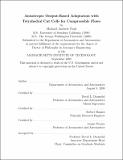| dc.contributor.advisor | David L. Darmofal. | en_US |
| dc.contributor.author | Park, Michael Andrew | en_US |
| dc.contributor.other | Massachusetts Institute of Technology. Dept. of Aeronautics and Astronautics. | en_US |
| dc.date.accessioned | 2009-08-25T17:59:22Z | |
| dc.date.available | 2009-08-25T17:59:22Z | |
| dc.date.issued | 2008 | en_US |
| dc.identifier.uri | http://hdl.handle.net/1721.1/46363 | |
| dc.description | Thesis (Ph. D.)--Massachusetts Institute of Technology, Dept. of Aeronautics and Astronautics, 2008. | en_US |
| dc.description | This electronic version was submitted by the student author. The certified thesis is available in the Institute Archives and Special Collections. | en_US |
| dc.description | "September 2008." | en_US |
| dc.description | Includes bibliographical references (leaves 153-164). | en_US |
| dc.description.abstract | Anisotropic, adaptive meshing for flows around complex, three-dimensional bodies remains a barrier to increased automation in computational fluid dynamics. Two specific advances are introduced in this thesis. First, a finite-volume discretization for tetrahedral cut-cells is developed that makes possible robust, anisotropic adaptation on complex bodies. Through grid refinement studies on inviscid flows, this cut-cell discretization is shown to produce similar accuracy as boundary-conforming meshes with a small increase in the degrees of freedom. The cut-cell discretization is then combined with output-based error estimation and anisotropic adaptation such that the mesh size and shape are controlled by the output error estimate and the Hessian (i.e. second derivatives) of the Mach number, respectively. Using a parallel implementation, this output-based adaptive method is applied to a series of sonic boom test cases and the automated ability to correctly estimate pressure signatures at several body lengths is demonstrated starting with initial meshes of a few thousand control volumes. Second, a new framework for adaptation is introduced in which error estimates are directly controlled by removing the common intermediate step of specifying a desired mesh size and shape. As a result, output error control can be achieved without the adhoc selection of a specific field (such as Mach number) to control anisotropy, rather anisotropy in the mesh naturally results from both the primal and dual solutions. Furthermore, the direct error control extends naturally to higher-order discretizations for which the use of a Hessian is no longer appropriate to determine mesh shape. The direct error control adaptive method is demonstrated on a series of simple test cases to control interpolation error and discontinuous Galerkin finite element output error. This new direct method produces grids with less elements but the same accuracy as existing metric-based approaches. | en_US |
| dc.description.statementofresponsibility | by Michael Andrew Park. | en_US |
| dc.format.extent | 164 leaves | en_US |
| dc.language.iso | eng | en_US |
| dc.publisher | Massachusetts Institute of Technology | en_US |
| dc.rights | M.I.T. theses are protected by
copyright. They may be viewed from this source for any purpose, but
reproduction or distribution in any format is prohibited without written
permission. See provided URL for inquiries about permission. | en_US |
| dc.rights.uri | http://dspace.mit.edu/handle/1721.1/7582 | en_US |
| dc.subject | Aeronautics and Astronautics. | en_US |
| dc.title | Anisotropic output-based adaptation with tetrahedral cut cells for compressible flows | en_US |
| dc.type | Thesis | en_US |
| dc.description.degree | Ph.D. | en_US |
| dc.contributor.department | Massachusetts Institute of Technology. Department of Aeronautics and Astronautics | |
| dc.identifier.oclc | 405564815 | en_US |
